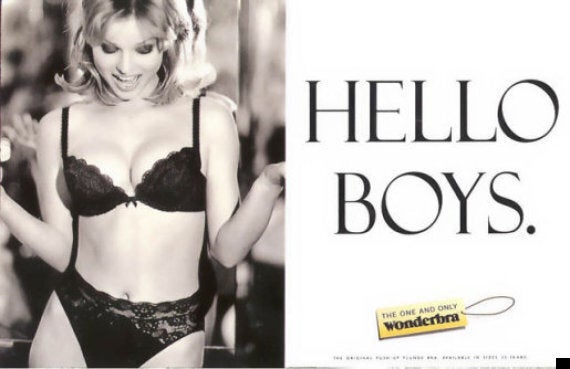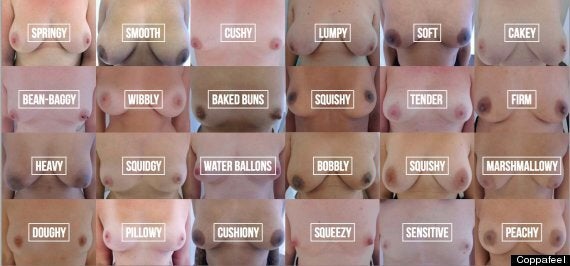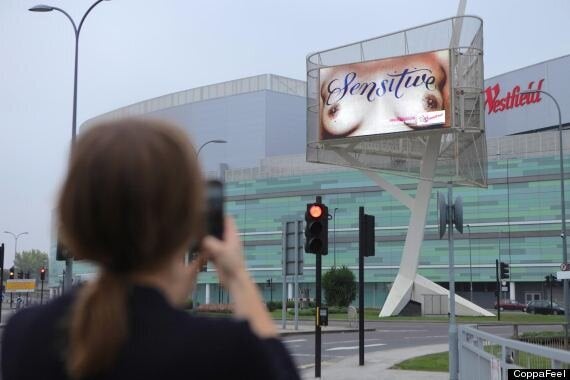I recently un-friended someone on Facebook over breasts.
He posted a comment during the heated debate over whether women should be allowed to breastfeed their children openly in public (yes, they should).
In a Facebook rant, my no-longer-friend said something along the lines of: "All these women breastfeeding in public are ridiculous. How would they feel if a man sat down next to them and started masturbating? It's disgusting."
Presumably he was aware that the point of breastfeeding is to feed and sustain a child, and that mothers have to do this every few hours to keep that child alive. Yet he still interpreted breastfeeding as a brazenly sexual, voyeuristic act, akin to pleasuring yourself.
This makes no sense. But still, it's what he thought.
Boobs are distracting. Those iconic 'Hello Boys' Wonderbra adverts starring supermodel Eva Herzigova looking down at her breasts were supposedly responsible for several car accidents on the Hammersmith gyratory system in the 1990s.

From today, unprecedented adverts will go one step further - featuring naked, unedited breasts on UK billboards for the first time at sites in London, Liverpool and Glasgow.
But this isn't to sell underwear, it's an important campaign from breast cancer charity CoppaFeel which is trying to "normalise" breasts and remind women to regularly check themselves for signs of cancer.
The idea behind the #WhatNormalFeelsLike ads is that hypersexualisation (think Wonderbra) means we think of boobs only in terms of size, not how they feel when you squidge them, which is key to spotting crucial signs.

It was hard to achieve - ironically because of the rules that try to stop ads being too arousing.
It is very hard to get breasts into advertising. The watchdog, the Committee of Advertising Practice, has strict rules about "sexualised images".
Fashion adverts are consistently banned for showing nipples in a provocative way. A banned YSL Opium perfume ad, featuring Sophie Dahl with one nipple exposed, is one of the 10 most-complained-about ads of all time.
But Coppafeel's ads definitely aren't sexualised - this is a charity trying to talk to women about their own bodies and health.
Yet ads showing breasts for health reasons face an uphill battle around the world. A Scottish government TV ad in 2012 showed bare breasts with signs of breast cancer, and led to a 50% uplift in women contacting their GP about symptoms. Yet, when a breast cancer foundation in New Zealand wanted to use the same pictures for a TV ad there, the New Zealand watchdog banned it, saying nipples were not permitted.
This seems bizarre if you consider the recent furore over Page 3 in The Sun. Campaigners and ministers can't seem to banish the daily topless lady in Britain's biggest selling "family" paper, yet it's a struggle to get some pictures of natural breasts on a billboard to prevent cancer.

To confuse matters, CoppaFeel has sparked controversy by partnering with The Sun for 'Check'em Tuesday', a weekly campaign encouraging women to check their breasts which The Sun claims has "saved the lives of five readers so far".
In some ways, the difference between a sexy perfume ad and a health campaign is obvious. It's all about the intention behind the image. But that intention depends on who's looking, something that was neatly satirised on the BBC's The Now Show last week: society divides images of breasts into good boobs and bad boobs. Renaissance painted boobs - good. Breastfeeding boobs - bad. Boobs for cancer checking - good. Page 3 boobs - bad.
But the advertising watchdog committee doesn't necessarily agree that CoppaFeel's boobs are "good" boobs. It was split about whether to allow the ads to appear at all.
So why did it have doubts about this evidently noble ad campaign? The pictures of real woman's breasts clearly aren't trying to be sexual. But are they sexual all the same?
Is the reality that any image of a breast is sexual and provocative, even if that very breast is being checked for signs of breast cancer?
I suppose, in the logic of the man who I unfriended, the answer is yes. A breast is sexual, no matter why it's there.
Of course, we come full circle here: my Facebook ex-contact is a victim of the very hypersexualisation that CoppaFeel is trying to overcome.
Reassuringly, when Coppafeel launched other ads with bare breasts last year - this time artistically edited by the photographer Rankin - there were no complaints. And, as far as we know, no car crashes.
But Facebook disabled the page of an illustration agency which posed the ads online, for showing nudity. As Karmarama, the ad agency which created the bare-boobed pictures, is finding out: the battle between good boobs and bad boobs is not clear cut.
Billboards are a particular danger area for advertising. They are classed as a "broadcast medium" like TV and radio, because if you walk past a billboard, you can't help but see what's on it, unlike a newspaper that you make the active choice to open. Children or religious people might walk by and be offended by semi-nude ads.
Mediacom, the media agency which helped to place CoppaFeel's ads, has tried to minimise this risk using GPS data to pick billboard sites which are likely to be near lots of young women that the ad is trying to reach, and not many children.
This system is nowhere near foolproof - people who don't want to see the breasts may see the ads and they may complain.
But hopefully, at the same time, more women will check their breasts for a life-threatening disease, and encourage others to do the same - that's definitely worth a bit of outrage.
And maybe others, like my Facebook ex-friend, will realise that breasts in themselves are just lumps of flesh and fat: not good or bad, not erotic or medical. They are just breasts.